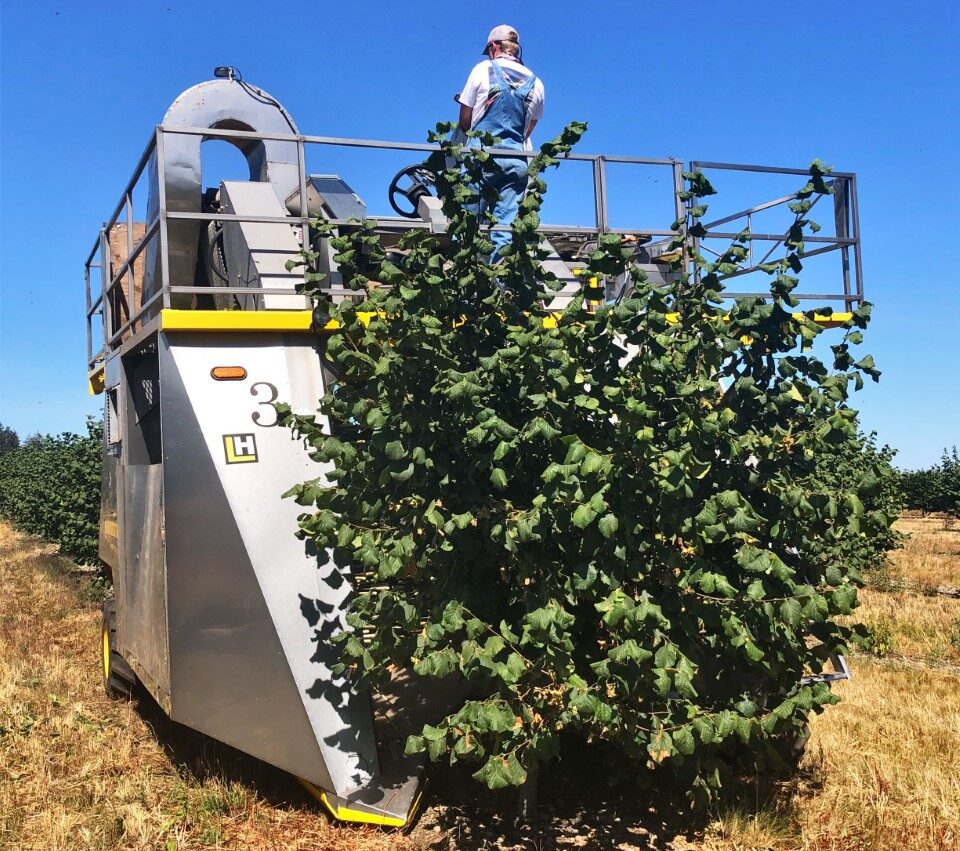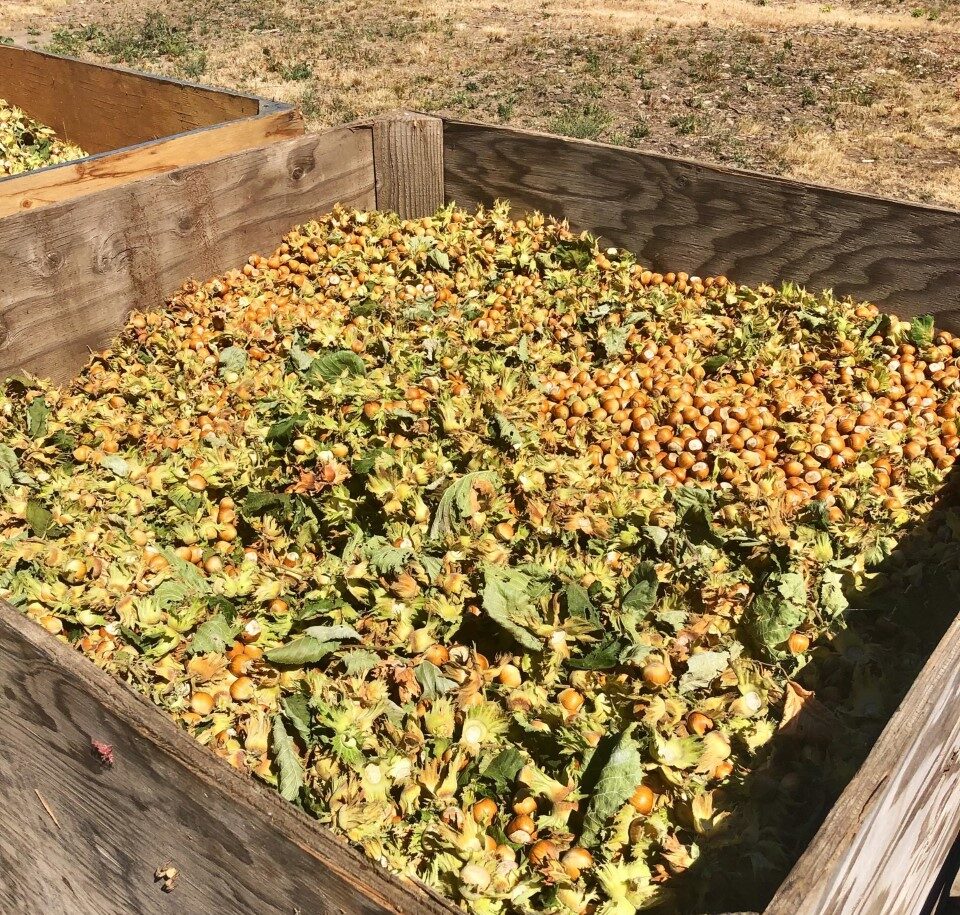
The rocky, river-bottom soil that Carter Clark’s young hazelnut orchard sits on is not conducive to conventional harvesting, and as trees were maturing, Clark was not looking forward to harvest. Fortunately, Andrew Herr, chief marketing officer of Littau Harvester, which is headquartered a couple of miles from Clark’s orchard in Stayton, Ore., offered Clark an alternative.
For a fee, Herr proposed, Littau could harvest the nuts with a mechanical blueberry harvester by going over the top of the young trees and catching the nuts before they ever hit the ground.
Clark jumped at the offer. The over-the-row harvester offered few drawbacks and many advantages, among them harvest timing. Because Clark didn’t have to wait until the husks released the nuts, he was able to get nuts to the processor a full 30 days ahead of most growers.
Then there is the speed with which he was able to complete harvest. “Whereas your traditional guys might be doing two to three sweeps during harvest, with the Littau harvester, you go over the entire row and you take every nut off that tree in one pass, and then you are done,” Clark said. “I started harvest on Sept. 1 and I was done harvesting my 30 acres on Sept. 2.”
Labor costs drop considerably with the over-the-row harvester, Clark said. And not having to prep the orchard floor prior to harvest is a huge advantage. “I can mow, say three times a year, with a rotary mower, and I’m not scraping. I’m not doing all the things you have to do to get that floor laser perfect.”
And despite that, Clark doesn’t believe food safety is a concern with conventional harvest, the idea that at some point in the future it could become an issue is something he keeps in mind. “Obviously, nobody eats the outside of a hazelnut,” he said, “so it may not ever be an issue to have nuts hit the ground, but it is something that people talk about.”
Still in Its Infancy
The idea of running a blueberry harvester over the top of young hazelnut trees was not new when Clark tried it. A few hazelnut growers had tried it in 2019 the year before he did. And Littau has even introduced an over-the-row harvester for tree fruits with a higher clearance that is now being viewed as an alternative for harvesting more mature hazelnut orchards. That harvester is available to rent from Littau.
Still, over-the-row harvest for hazelnuts is an idea very much in its infancy, Littau’s Herr said, albeit one generating considerable interest.
“I always get calls about it,” said Nik Wiman, Oregon State University Extension hazelnut specialist. “I think a lot of people are interested in it.”
Ryan Flaherty, grower relations manager for the farmer-owned co-op Hazelnut Growers of Oregon, posted a video on the social network platform LinkedIn earlier this year of the Littau ORXL harvester at work in a hazelnut orchard that received more than 30,000 views.
“It traveled the world,” Flaherty said. “I had people from Italy, Spain and Turkey reach out to me about it.”
Still, gaining widespread adoption of the practice has several obstacles, according to Wiman, primarily that hazelnut trees tend to get large as they mature, too large for over-the-row harvesters to clear, even the Littau over-the-row extra-large harvester, or ORXL.
“I know the OSU Hazelnut Breeding Program is looking at releasing some more compact trees that will remain smaller,” Wiman said, “but we don’t have rootstocks in hazelnuts like they do in tree fruits, where thßey can use highly dwarfed rootstock to create a smaller tree. There is some grafting going on, but it is not for dwarfing purposes, so that is kind of a missing link in the chain as far as being able to have a super-high-density orchard of smaller trees.”

Hedgerow Pruning
Pruning trees into hedgerows under more dense plantings could offer a means to keep trees small, Wiman said.
“I think growers could successfully keep the trees relatively small with hedging,” he said. “And I definitely think there is going to be some movement toward that, especially because we are planting a wider variety of soil types with hazelnuts, including some that are not as productive as historically nuts were produced on. In those cases, the tendency is for growers to go to slight tighter spacings, with the assumptions that the trees are not going to reach the size they would on a different soil type.”
Clark noted that he is planning to do some hedging this year in hopes of keeping his trees smaller longer. “Maybe the orchard of the future is narrow, tight hedgerows, and you are running a machine over the top to pick them,” Clark said.
To date, however, most are looking at the over-the-row harvester as a short-term option, something to abandon once trees reach maturity.
Another hurdle to widespread adoption of over-the-row harvesting is that, unlike in conventional harvests where nuts release from husks before being swept off the orchard floor, with over-the-row harvest, husks have to be removed at the processing plant. “Removing that husk at the wash plant is a challenge,” Flaherty said.
Still, Clark said, he found that some processors were okay with removing husks as long as the nuts come into the plant early in the season.
“I think it is scary for processors, because it is so different,” Clark said. “But it seems like a few receiving stations have figured it out. It takes more work, but they are your first nuts in. You don’t have trucks sitting behind these nuts waiting to go, so you’ve got a little time to dial in your machines. And if you have to run them twice, well, they are probably the only nuts at your facility right then, so you have time to work with them.
“I think it would be a lot harder for the processors if these were mid- or late-season nuts coming in this way,” Clark said, “but because they are early, they have a little more flexibility.”
Tree Health
Another question still looming over widespread adoption of the practice is how the harvesters will affect the long-term health of a tree, and, more specifically, next year’s crop.
“That is another aspect to this that is not clearly understood,” Wiman said. “If you are knocking off a lot of catkins with the harvester, you have to wonder how harmful that is to your next year’s crop.”
Timing harvest in a way that maximizes yield is another issue yet to be fully understood, Wiman said. “It is efficient,” Wiman said of the harvester, “but there is a lot of crop that is knocked on the ground just by the fact you have this big machine going through the orchard and it can’t catch every nut that drops. That is another piece of the puzzle that I think needs to be figured out.”
Still, even with the unanswered questions and even provided that at least in the short term, use of the over-the-row harvester will be isolated to young orchards, with so many acres in the Willamette Valley at early stages, there is a huge potential for applying this technology, Wiman said.
Clark agreed. “In your first year of production, you are probably only going to get a couple of hundred pounds of nuts [per acre], and if that hits the ground, that is an awful lot of work for not much gain,” Clark said. “But if you can go through really quick with a Littau harvester and knock every nut off that tree, for the guys that already own that machine, I think that could make a lot of sense.”










